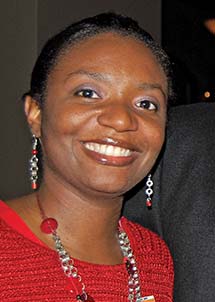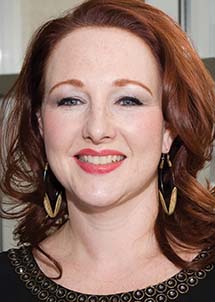Many people can’t imagine enjoying fundraising. Selling people something is one thing—but asking for support in exchange for a thank-you note and a tax write-off? For most of us that sounds…difficult.
“I think early on there can be a little bit of a ‘fundraising is a dirty word’ mentality, and asking people for their money is an inconvenience,” concedes Gretchen H. Page, major gifts officer at the Public Theater in New York City. “Somewhere along the line for me, and I think for everyone who’s in this field, that shifts, and you think about it as a privilege. People want to be helpful, and connecting them in a way where they can feel like that with something they really love is a privilege.”
Indeed, donations are crucial to all nonprofit organizations, but those who donate to theatres get more than thanks and a tax break. Their support enables arts institutions to become community hubs, provide arts education programming for kids, allow students to see theatre at an affordable price, support new works, and much more.
But how do you go from being afraid of the ask to being master of it? Four development pros who spoke to American Theatre talk about the secrets to getting started, fundraising fundamentals, and the future of their field.
Finding the Way to Fundraising
“I didn’t really know this existed,” says Kelly Burdick, director of development for the American Shakespeare Center in Staunton, Va. Like many others working in theatre development, Burdick entered via the stage door.
“I was a performer from the time I was a kid up until about the middle of college,” she says. “I didn’t want to do that anymore, but I didn’t know about the administrative side.” She ended up doing clerical work for a theatre company, then went on to other administrative positions before finding development.

LaTeshia Ellerson, development director for Kenny Leon’s True Colors Theatre Company in Atlanta, has a similar story, though she had some prior fundraising experience, having worked for United Way of Metropolitan Chicago after college while pursuing her first love, acting. When she moved to Atlanta, she looked for audition opportunities—and saw a development officer position at True Colors.
“I thought, hey, that would be a great way to marry my love and passion for theatre with this new skill set that I had for fundraising,” she says.
Lori Moore-McMullen is an outlier, having come to theatre development from, well, development. While in college, she worked for the Multiple Sclerosis Society and was hired there as soon as she graduated. After more than 15 years at that job, she took a position at the Repertory Theatre of St. Louis, where she’s been director of development for nearly 12 years.
“It’s a wonderful organization and a great place to work,” she says. “People here don’t transition very quickly.”
Many people in theatre administration have a story closer to that of the Public’s Page. She loved performing as a kid, but she always knew “who the best person on that stage was—and that was never me. I loved the community around it, and I loved the work itself, but I think I knew early that the right place for me was behind the scenes.”
After college, she jumped into thea-tre administration and found her niche in development. “It’s a great marriage of creative and analytical,” she says. “You have to be able to speak both languages in development really well: You have to speak to the numbers and be able to tell the story behind them in a compelling way.”
Developing Skills
Getting fluent in the languages of development takes time, and is best learned on the job through a mentor.
“It’s kind of hard to start from scratch in this field,” Burdick says. “But if you find a good mentor, somebody who is really going to take you by the hand and guide you through when you’re first starting, then you should be okay.”
Mentorship can be a lasting relationship: Ellerson says that even though the woman who helped her learn the ropes at True Colors has moved on, “I still contact her, ask her questions.” She also recommends joining a professional organization for development, and getting to know fundraisers outside of the theatre sphere.
“Learning from other industries and their fundraising, especially for individuals, I think is very important,” Ellerson says. “Networking with other development professionals outside of theatre allows me to build relationships with corporations and people who may not think that they would donate toward the theatre.”
Fundraising From the Classroom
While most development professionals learn on the job, Burdick and Page both went to graduate school. Burdick studied arts administration and Page got an MFA in management and producing.
Burdick says that learning how nonprofit organizations work was edifying, but admits, “I don’t think there’s a whole lot about fund-raising that can be taught in a classroom.” Page’s experiences taught her that she wasn’t as interested in for-profit theatre, and she returned to the nonprofit world.
Though there are nonprofit administration courses at many colleges nowadays, Page recommends studying communications, English, or theatre. Internships and entry-level jobs remain the best way to get started in the field.
“You really have to get out there as much as you can. Any place where there’s a thea-tre market, get your boots on the ground there in the development department,” Page says. “And be proactive. Roll up your sleeves and jump in.”
The Matchmakers
When Burdick was working for the Classical Theatre of Harlem in New York City, before her current job, she remembers bringing a potential major donor to a holiday show.
“He just fell in love with the company through that,” she says. “And over the course of a couple years, we were able to invite him to things and show him who we are and what we do, and eventually he was able to fund us in a big way, and over the course of many years.”
Burdick and others in development often refer to fundraising as “matchmaking.” Most theatre fundraising focuses on substantial gifts from individual donors, corporations, or foundations, which means that development officers must build a wide network to find potential donors and foster personal connections.
“Many people compare fundraising to a relationship,” Ellerson says with a laugh. “You can’t just go straight to home base. You have to go through certain steps in order to build that relationship in the courting phase from loyalty and then to donations.”

“It’s important to be very personable,” Moore-McMullen says. “You need to be able to have those conversations, listen to what people are saying, and understand what donors are interested in supporting.”
Burdick agrees. “People or institutions have funds that they want to give, and they have causes that make their heart sing,” she says. “My job is to see if what we do is that thing that makes their heart sing. And if it is, most of the time they will volunteer their funds.”
Finding the Right Fit
When Burdick started at Classical Theatre of Harlem, the company was more than $300,000 in debt, and Burdick was one of the few paid employees. “We were living very close to the bone,” she recalls. (Under her leadership, CTH retired that debt and built a cash reserve.) “But everybody in the nonprofit world feels resource-poor. Most, if not all, not-for-profit theatres are working beyond their capacity. We are all stretched very thin.”
That means “you have to have something that’s going to drive you,” Burdick says. “It’s not the paycheck, and it’s not easy working conditions. Sometimes it takes you putting in those 10-hour days, those 12-hour days, and you have to actually care about what you’re doing in order to want to do that on an ongoing basis.”
Page agrees. “You have to be genuinely enthused about what it is your company is putting out there into the world,” she says. “At the end of the day, it can’t be about you, really, in this field. It has to be about the work on the stage.”
Theatre development departments often have a high turnover rate, as deeper-pocketed nonprofits such as hospitals and universities can attract fundraising talent to more lucrative and stable careers. But Moore-McMullen and Ellerson have both been in development with a single theatre company for a decade or longer, and they attribute their longevity to their companies being a great fit for them.
“I really, really love our people here,” Moore-McMullen says about the Rep. “They are a joy to be with, and we couldn’t do what we do without them.”
For her part, Ellerson loves True Colors’ mission, which she sums up as, “How can we bring people together? How can we tell stories that share something universal about the human condition and inspire empathy?”
Ellerson remembers completing a core values assessment and realizing that her values and True Colors’ matched. “Not every fundraising professional is able to find an opportunity where they are passionate about the mission to their core,” she says. “It’s a perfect match.”
The Future of Fundraising
When theatre development officers look into their crystal ball, a few things make them nervous.
“Anyone who is not paying attention to tax code legislation should be,” says Page. As Baby Boomers age, planned giving—essentially, naming theatres as beneficiaries in your will—is predicted to be a huge boon for not-for-profits across America. Changes in the tax code—particularly the recently passed tax bill, which will raise the estate tax cap—may make planned giving less attractive as a tax shelter. But Page says that nonprofits should continue to leverage planned giving from their donors.
“I would say that if you’re in any nonprofit in the country you should have planned giving up and running just so you can be getting bequests from people in their will,” she says.

The National Endowment for the Arts can also be threatened by government changes. “It’s not a relatively large amount of money that the NEA give out,” says Burdick. “But it is an indicator of what we believe as a country.”
When the arts are under threat, arts organizations feel threatened too, as the government essentially says that the arts aren’t worth funding. That’s why Page encourages organizations to get involved in arts activism.
“The NEA can’t necessarily act as an advocacy organization, but there’s no saying we can’t stand up and fight for ourselves and I think we all need to mobilize in that and stand up for our field,” she says.
Ellerson sees activism in theatre as having another benefit too. “Millennials want to engage in cause-related issues,” she says. “And we need to make sure we’re cultivating new audiences and serving them.”
Growing an Audience
Many a person involved in theatre will lament audience demographics which persistently skew older and white. Burdick, however, is optimistic.
“Theatre’s been dying since long before I got involved with it,” she says. “I just don’t buy it. I really don’t. I think that people have more free time and more funds later in life, so it makes sense that people re-engage with the arts when they’re older.”
Still, the key word is “re-engage.” Most older donors were introduced to the arts as a kid or young adult, and that spark lit their philanthropic passion later. So it is still key to get kids exposed to art, something that Moore-McMullen works to do in her role at the Rep.
“We have a lot of donors and a lot of grant support going toward transportation and tickets for young people to come to the theatre, and also for us to take the theatre to them,” she says.
Unfortunately, many public schools have been cutting arts budgets in favor of the study of science, technology, engineering, and math (STEM). That has likewise moved corporate dollars away from arts education.
“I think some organizations, because their business is about math and science, they really want to fund particular projects where they see a future,” Moore-McMullen says. “And the arts don’t fall in their purview right now. But there is a move where we’re adding the A to STEM, with STEAM, so I think the arts are coming back.”
The STEM challenge has inspired Burdick. “One of my goals is always to get non-arts funding,” she says. “If you have a funder that only wants to fund STEM education because public education has all but left out the arts, you can show them how much science, technology, engineering, and math goes into a production. If you can convince them to fund your theatre, then you have won, because you have won non-arts dollars.”
Over the course of her career, Page too has noticed funding trends of both the promising and troubling variety. She began fundraising right before the economic crash in 2008, then stepped away for a couple of years for graduate school. When she reentered, the field had changed, she recalls.
“It was very different when I came back,” she says. “Mostly, it was a shift away from corporate foundations and into individual philanthropy.” Major corporations had shifted focus or moved to more local giving where they were headquartered.
But no matter what shifts in the cultural zeitgeist, Page remains optimistic.
“It seems like in philanthropy, to me at least, if you’re Mark Zuckerberg and you really profited from your involvement in tech, you’re going to be inclined to fund tech education,” she says. “Whereas if you are Lin-Manuel Miranda and your arts education has made all the difference in your life, then that’s where your passion is going to lie. Ultimately, philanthropy is about what you care about.”
The Digital Distraction
But new tech is plaguing theatre companies in one area: as competition for attention.
“There are so many mediums vying for everyone’s attention that it is sometimes hard for us to get our message to donors and potential donors,” says Moore-McMullen. “They’re receiving so many emails and there’s so much on social media.”
Some attention-getting trends include Giving Tuesday, which follows Black Friday and Cyber Monday, as a day for people to give to charitable organizations. There’s also charitable giving through rounding up ticket sales, or adding $10 or $25 to a purchase. But getting people’s attention, especially for small gifts, is still a challenge.
But tech challenges theatres in another, more fundamental way. In a word: Netflix. If entertainment is so cheap and convenient, how does theatre compete?
“Whenever I’m here at the Blackfriars, which is our theatre, I think about all of the people that ever were and all the people that ever will be, and I’m one of 300 that are seeing this moment, and that’s it,” says Burdick. “I think that’s amazing. Or I’m one of 1,400 in Marcus Garvey Park [in Harlem] to see the closing night of Macbeth, where it poured rain through the last scene and everybody stayed. How extraordinary to be one of those people.”
For development officers and audiences, it all comes back to what’s onstage—that moment when the house lights go down and all the hard work comes to fruition. “It’s great when you see people who are introduced to theatre for the first time,” says Ellerson. “When we have our matinee for young people, you actually see the glow on their faces. It’s definitely a rewarding feeling.”
Rosalind Early is the associate editor of the alumni magazine for Washington University in St. Louis and a freelance theatre critic for St. Louis Magazine.





